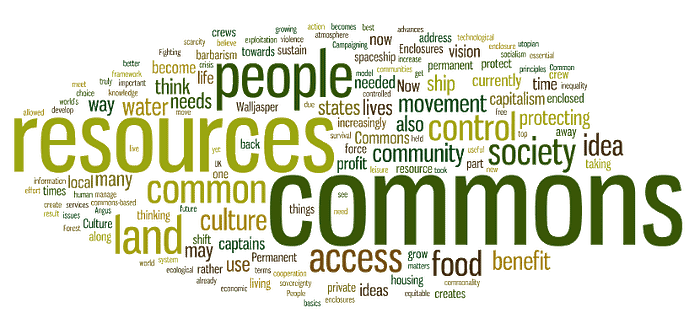Will the Commons disrupt the Market and State?

“The word “commons” has many meanings” But it also refers to the institutional order for the exploitation of (generally limited) communal or common resources, which is the meaning we intend to delve into…” the woman with straight white hair was telling the man that appeared to be several years younger as they took the seats facing mine. They were so near me, it was impossible not to overhear their conversation.
What this woman was saying attracted my attention, relating as it did to my own thoughts and ideas, and revealing as well a new perspective for looking at problems I had until then considered unsolvable. As soon as I had a chance, I gathered courage and introduced myself. “Nice to meet you. My name is Elinor Ostrom,” she said. Thus I realized that this modest-looking woman was not just any passenger — she was no less than a Nobel Prize in Economics laureate.

Elinor Ostrom –who died in June 2012, exactly two years after we traveled together by train to attend a forum in Tallberg, a village in northern Sweden,– was an American political scientist who devoted much of her life to studying cooperative management and organization. Her most important work is undoubtedly Governing the Commons: The Evolution of Institutions for Collective Action, published in 1990. Years later, in 2006, she published Understanding Knowledge as a Commons: From Theory to Practice. Both works, which are completely innovative from the economic and political theory viewpoints, have much to do with what is currently emerging, as shall be seen below.
But first things first — what do we talk about when we talk about commons?
In principle, “commons” resources are owned by a group of people by reason of where they live. No one, in particular, has exclusive control of, or monopoly on their use. When the common coexistence rules are not enough to regulate their exploitation, certain rules are established which arise from a combination of traditions and agreements to which the community subjects itself. But this is not always the case. The ambitions of a few often end up exhausting a common resource, to the detriment of all.
In this line, the issue of world overpopulation inspired American scientist and ecologist Garrett James Hardin to write the so-called “tragedy of the commons.” The controversial article was published in 1968 and triggered a heated debate. Hardin’s subject is demographic growth in a finite world. Among other considerations, Hardin asserts that free and unrestricted access to limited resources leads to overexploitation because benefits are individual, while the exploitation costs are borne by all. This ultimately results in the destruction of the resource, to the detriment of all.
“The power of non-cooperation is greater than the power of cooperation,” concludes Hardin, whose thesis refers to human behavior, discarding the possibility of a “technical” answer to the dilemma.
“Therein is the tragedy. Each man is locked into a system that compels him to increase his herd without limit — in a world that is limited. Ruin is the destination toward which all men rush, each pursuing his own best interest in a society that believes in the freedom of the commons. Freedom in a commons brings ruin to all.”

For Garret Hardin, the only answer to the tragedy of the commons was centralization, control, and central management of resources, in order to prevent local decisions from irreparably damaging both resource and social collective. Hardin appropriates, in his own manner, the philosophical ideas of Thomas Hobbes, the great theorist of Absolutism, whose profound influence he acknowledges.
Ostrom, whose ideas shall be analyzed below, questions this type of reasoning.
Unlike Hobbesian philosophy and the tenets of Garrett Hardin, Elinor Ostrom –who was awarded the 2009 Nobel Prize in Economics and was not an economist– showed that privatization is not the only way in which common assets can be managed successfully.
Ostrom points out that cooperation between individuals can exist and that self-government of a common asset is possible without involving third parties or entities outside the execution group. She affirms that people, on the basis of a series of clear rules, can generate an institutional system different from market and State and that there are centuries-old cases of self-government from different parts of the world, older even than Hobbes, in which sustainable resources could be maintained. She showed that it is possible to promote cooperation as human behavior.
“Ruin is the destination toward which all men rush, each pursuing his own best interest in a society that believes in the freedom of the commons,” Hardin wrote in his famous and bleak article.
Hobbes and Hardin think that coercion is the only way to provide security and order.
But Ostrom hacks this idea and proposes solutions alternative to those offered by the theorists of State and privatization. In her work, she argues that individuals can sometimes create non-coercive institutions that offer people the security they need, where people assume that private and group interests can strengthen each other — as with bitcoin and the blockchain, where miners, pursuing their own interest, create a secure framework for everyone. What Ostrom proposes is the self-government of the commons through binding commitments between those who participate in using the resource. Insofar as individuals trust a community and its management mechanisms, they will be willing to abide by the community’s rules, to help uphold them, and to monitor compliance to keep the resource safe and sustainable for collective welfare. “What we have ignored is what citizens can do and the importance of real involvement of the people involved,” Ostrom says.
This idea completes the definition of the commons as the coupling of community and resource in a conscious relationship. What emerges from that system is self-government. Community, resource, awareness, self-government, are thus the keys to disrupting the logic of our current capitalism that is leading us to the abyss as a result of individual efforts to obtain the highest profit in ruthless competition against others.
The commons conjure up a holistic and ecologic vision of the world, based on relations of reciprocity, cooperation, and community and breaking with the individualistic-capitalist vision. The commons are based on inclusion and equality before the law, outside reductionism, and commoditization. The commons cannot be commercialized or transferred, because they cannot be subject to individual ownership. Their logic is qualitative, not quantitative.
But Ostrom did not stop at the formulation of the theoretical elements of collective actions — rather, she devoted her efforts to studying the specific cases of different institutions, analyzing their physical and cultural conditions and their historical traditions.
One of these cases is that of the village of Torbel, in the Swiss Alps, which has successfully managed the communal property of forests and grazing lands for centuries, maintaining sustainable resources and avoiding, to this day, the fatal tragedy prophesied by Garrett Hardin.

The first written rules can be traced back to the thirteenth century. On February 1, 1483, the villagers of Torbel created an association to regulate the communal exploitation of the wood from their forests and the use of their high Alpine grazing meadows. In 1517, they set forth grazing rules that are still in force. They established that the villagers can put their cattle out to pasture in the mountain during the summer, but may not send more cows than they can feed in the winter. The cows are sent up to the highest Alpine lands all at the same time and immediately counted since each household is allocated cheese in proportion to the cows it owns. It is not irrelevant to mention that this case is prior to Hobbes’s Leviathan, which shows the limits encountered when attempting to describe human nature with one’s back turned to specific historical developments.
In support of her conclusions, Ostrom analyzes other cases temporally, geographically, and culturally distant from the Torbel example, such as the irrigation of Spanish orchards, irrigation in the Philippines, and the management of communal lands in Japan. She derives from these a series of basic principles of institutional design:
1. The limits of the resource are clearly defined.
2. The rules governing the use of collective assets are well adjusted to local needs and conditions.
3. The majority of the people affected by these rules can participate in modifying them.
4. The community members’ right to design their own rules is respected by external authorities.
5. There is a surveillance system for the members’ behavior; community members agree to perform this monitoring.
6. Conflict resolution systems must be clear, simple, accepted by all, and not subject to appeal.
7. The communities’ right to create and apply the resource management rules is respected by the state authorities.
8. The organization of great communal assets is performed through multiple levels of organizations integrated with each other, which are responsible for the supervision, conflict resolution, application of decisions, and regulation.
In a conclusion, Ostrom showed that rules can arise from bottom to top, creating a new type of institution that ensures the shared, sustainable, and economically efficient management of resources. Ultimately, community and resources make up a system. From the dynamic and conscious interaction of these elements, self-government arises. And the purpose of the system is sustainability. A shared ownership relationship implies shared responsibility and awareness. Trust, hitherto placed in central institutions –banks, states, great corporations– backed by the power of coercion, can be transferred to a system and to the people who inspire it and who commit themselves to support and improve it.
Ernesto van Peborgh— Is Co-founder of Regenerative Designers, advising on regenerative business ecosystem systems design.
Author of several books, among them, HomoHacker: managing complexity to overcome planetary challenges









